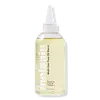What's inside
What's inside
 Key Ingredients
Key Ingredients

 Benefits
Benefits

 Concerns
Concerns

 Ingredients Side-by-side
Ingredients Side-by-side

Cyclopentasiloxane
EmollientDimethicone
EmollientPrunus Amygdalus Dulcis Oil
Skin ConditioningIsododecane
EmollientHydrogenated Ethylhexyl Olivate
EmollientC12-15 Alkyl Benzoate
AntimicrobialPhenyl Trimethicone
Skin ConditioningSimmondsia Chinensis Seed Oil
EmollientDimethiconol
EmollientJojoba Esters
EmollientButyrospermum Parkii Butter
Skin ConditioningHelianthus Annuus Seed Oil
EmollientOryza Sativa Bran Oil
EmollientAdansonia Digitata Seed Oil
EmollientBorago Officinalis Seed Oil
EmollientCrambe Abyssinica Seed Oil
Skin ConditioningGlycine Soja Oil
EmollientPassiflora Edulis Seed Oil
EmollientMoringa Oleifera Seed Oil
EmollientCoconut Alkanes
EmollientKaempferia Galanga Root Extract
Skin ConditioningHelianthus Annuus Extract
EmollientAmaranthus Caudatus Seed Extract
Skin ConditioningOryza Sativa Bran Extract
Skin ConditioningDaucus Carota Sativa Root Extract
Skin ConditioningRosmarinus Officinalis Leaf Extract
AntimicrobialTocopherol
AntioxidantCoco-Caprylate/Caprate
EmollientEthylhexyl Methoxycinnamate
UV AbsorberPolysilicone-15
UV FilterDiisostearyl Malate
EmollientHydrogenated Olive Oil Unsaponifiables
EmollientBeta-Carotene
Skin ConditioningBHT
AntioxidantCitric Acid
BufferingBenzoic Acid
MaskingPhenoxyethanol
PreservativeParfum
MaskingBenzyl Benzoate
AntimicrobialCitronellol
PerfumingBenzyl Salicylate
PerfumingLinalool
PerfumingHydroxycitronellal
PerfumingHexyl Cinnamal
PerfumingGeraniol
PerfumingCyclopentasiloxane, Dimethicone, Prunus Amygdalus Dulcis Oil, Isododecane, Hydrogenated Ethylhexyl Olivate, C12-15 Alkyl Benzoate, Phenyl Trimethicone, Simmondsia Chinensis Seed Oil, Dimethiconol, Jojoba Esters, Butyrospermum Parkii Butter, Helianthus Annuus Seed Oil, Oryza Sativa Bran Oil, Adansonia Digitata Seed Oil, Borago Officinalis Seed Oil, Crambe Abyssinica Seed Oil, Glycine Soja Oil, Passiflora Edulis Seed Oil, Moringa Oleifera Seed Oil, Coconut Alkanes, Kaempferia Galanga Root Extract, Helianthus Annuus Extract, Amaranthus Caudatus Seed Extract, Oryza Sativa Bran Extract, Daucus Carota Sativa Root Extract, Rosmarinus Officinalis Leaf Extract, Tocopherol, Coco-Caprylate/Caprate, Ethylhexyl Methoxycinnamate, Polysilicone-15, Diisostearyl Malate, Hydrogenated Olive Oil Unsaponifiables, Beta-Carotene, BHT, Citric Acid, Benzoic Acid, Phenoxyethanol, Parfum, Benzyl Benzoate, Citronellol, Benzyl Salicylate, Linalool, Hydroxycitronellal, Hexyl Cinnamal, Geraniol
 Reviews
Reviews

Ingredients Explained
These ingredients are found in both products.
Ingredients higher up in an ingredient list are typically present in a larger amount.
Baobab seed oil is an emollient. It is rich in fatty acids and vitamins A, E, and D.
The fatty acid content of this oil is roughly 30-40% oleic acid, 24-34% linoleic acid, and 18-30% palmitic acid. This gives it skin hydrating and nourishing properties.
Due to this fatty acid content, this ingredient may not be fungal-acne safe.
Fun fact: Our skin uses fatty acids, and especially linoleic acid, for creating ceramides.
Learn more about Adansonia Digitata Seed OilPrunus Amygdalus Dulcis Oil comes from the sweet almond, a tree native to Iran. This oil has no fragrance and is non-volatile.
Almonds contain healthy fats, vitamins, and minerals. It is a rich source of Vitamin E, a great antioxidant and skin conditioning ingredient. Sweet almond oil contains fatty acids such as linolenic acid and triglycerides.
The content of sweet almond oil makes it a great emollient; it can help soften and hydrate your skin. Emollients create a barrier over your skin to trap moisture in. Sweet almond oil has antioxidant properties.
Those with an almond allergy should be careful of this ingredient and speak with a professional about using it in your skincare.
This ingredient may not be fungal-acne safe.
Learn more about Prunus Amygdalus Dulcis OilThis oil comes from the seeds of the desert shrub called Jojoba. It is more commonly known as jojoba oil, a non-comedogenic oil.
Jojoba oil does not contain fragrance and has many fatty-acids, making it a great soothing ingredient.
It also contains Vitamin E, a great moisturizing ingredient. Vitamin E is also an antioxidant and protects your skin against oxidative damage.
This ingredient humectant properties, meaning it helps draw moisture from the air. This helps keep your skin hydrated.
While jojoba has antibacterial properties, it is only able to kill some strains of bacteria.
Studies also show it helps in wound healing. In fact, Indigenous cultures have used jojoba as a moisturizer and to help treat burns for centuries.
Fun fact: Jojoba oil similar to natural human skin sebum, so it has a great effect on dry skin. It is also promising with helping to regulate sebum production.
Due to its fatty acid content, Jojoba oil may not be fungal acne safe. We recommend speaking with a professional if you have any concerns.
Learn more about Simmondsia Chinensis Seed OilTocopherol (also known as Vitamin E) is a common antioxidant used to help protect the skin from free-radicals and strengthen the skin barrier. It's also fat soluble - this means our skin is great at absorbing it.
Vitamin E also helps keep your natural skin lipids healthy. Your lipid skin barrier naturally consists of lipids, ceramides, and fatty acids. Vitamin E offers extra protection for your skin’s lipid barrier, keeping your skin healthy and nourished.
Another benefit is a bit of UV protection. Vitamin E helps reduce the damage caused by UVB rays. (It should not replace your sunscreen). Combining it with Vitamin C can decrease sunburned cells and hyperpigmentation after UV exposure.
You might have noticed Vitamin E + C often paired together. This is because it is great at stabilizing Vitamin C. Using the two together helps increase the effectiveness of both ingredients.
There are often claims that Vitamin E can reduce/prevent scarring, but these claims haven't been confirmed by scientific research.
Learn more about Tocopherol